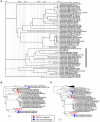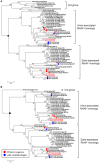Replications of Two Closely Related Groups of Jumbo Phages Show Different Level of Dependence on Host-encoded RNA Polymerase
- PMID: 28659872
- PMCID: PMC5468394
- DOI: 10.3389/fmicb.2017.01010
Replications of Two Closely Related Groups of Jumbo Phages Show Different Level of Dependence on Host-encoded RNA Polymerase
Abstract
Ralstonia solanacearum phages ΦRP12 and ΦRP31 are jumbo phages isolated in Thailand. Here we show that they exhibit similar virion morphology, genome organization and host range. Genome comparisons as well as phylogenetic and proteomic tree analyses support that they belong to the group of ΦKZ-related phages, with their closest relatives being R. solanacearum phages ΦRSL2 and ΦRSF1. Compared with ΦRSL2 and ΦRSF1, ΦRP12 and ΦRP31 possess larger genomes (ca. 280 kbp, 25% larger). The replication of ΦRP12 and ΦRP31 was not affected by rifampicin treatment (20 μg/ml), suggesting that phage-encoded RNAPs function to start and complete the infection cycle of these phages without the need of host-encoded RNAPs. In contrast, ΦRSL2 and ΦRSF1, encoding the same set of RNAPs, did not produce progeny phages in the presence of rifampicin (5 μg/ml). This observation opens the possibility that some ΦRP12/ΦRP31 factors that are absent in ΦRSL2 and ΦRSF1 are involved in their host-independent transcription.
Keywords: Ralstonia solanacearum; genomic analysis; jumbo phages; virion-associated-RNA polymerase; ΦKZ-like phages.
Figures




Similar articles
-
Two asian jumbo phages, ϕRSL2 and ϕRSF1, infect Ralstonia solanacearum and show common features of ϕKZ-related phages.Virology. 2016 Jul;494:56-66. doi: 10.1016/j.virol.2016.03.028. Epub 2016 Apr 12. Virology. 2016. PMID: 27081857
-
Multisubunit RNA Polymerases of Jumbo Bacteriophages.Viruses. 2020 Sep 23;12(10):1064. doi: 10.3390/v12101064. Viruses. 2020. PMID: 32977622 Free PMC article. Review.
-
Jumbo Bacteriophages: An Overview.Front Microbiol. 2017 Mar 14;8:403. doi: 10.3389/fmicb.2017.00403. eCollection 2017. Front Microbiol. 2017. PMID: 28352259 Free PMC article.
-
The Dynamics of Synthesis and Localization of Jumbo Phage RNA Polymerases inside Infected Cells.Viruses. 2023 Oct 16;15(10):2096. doi: 10.3390/v15102096. Viruses. 2023. PMID: 37896872 Free PMC article.
-
Emerging Aspects of Jumbo Bacteriophages.Infect Drug Resist. 2021 Nov 30;14:5041-5055. doi: 10.2147/IDR.S330560. eCollection 2021. Infect Drug Resist. 2021. PMID: 34876823 Free PMC article. Review.
Cited by
-
Isolation and characterization of two homolog phages infecting Pseudomonas aeruginosa.Front Microbiol. 2022 Jul 14;13:946251. doi: 10.3389/fmicb.2022.946251. eCollection 2022. Front Microbiol. 2022. PMID: 35935197 Free PMC article.
-
Genomic Characterization of Jumbo Salmonella Phages That Effectively Target United Kingdom Pig-Associated Salmonella Serotypes.Front Microbiol. 2019 Jul 2;10:1491. doi: 10.3389/fmicb.2019.01491. eCollection 2019. Front Microbiol. 2019. PMID: 31312191 Free PMC article.
-
Identification of Huge Phages from Wastewater Metagenomes.Viruses. 2023 Nov 28;15(12):2330. doi: 10.3390/v15122330. Viruses. 2023. PMID: 38140571 Free PMC article.
-
Complete genome sequence of a Ralstonia-infecting jumbo phage isolated from Maryland, USA.Microbiol Resour Announc. 2025 Jun 12;14(6):e0105124. doi: 10.1128/mra.01051-24. Epub 2025 May 7. Microbiol Resour Announc. 2025. PMID: 40332378 Free PMC article.
-
Biological and Molecular Characterization of a Jumbo Bacteriophage Infecting Plant Pathogenic Ralstonia solanacearum Species Complex Strains.Front Microbiol. 2021 Sep 27;12:741600. doi: 10.3389/fmicb.2021.741600. eCollection 2021. Front Microbiol. 2021. PMID: 34646257 Free PMC article.
References
-
- Bhunchoth A., Phironrit N., Leksomboon C., Chatchawankanphanich O., Kotera S., Narulita E., et al. . (2015). Isolation of Ralstonia solanacearum-infecting bacteriophages from tomato fields in Chiang Mai, Thailand, and their experimetal use as biocontrol agents. J. Appl. Microbiol. 118, 1023–1033. 10.1111/jam.12763 - DOI - PubMed
LinkOut - more resources
Full Text Sources
Other Literature Sources

